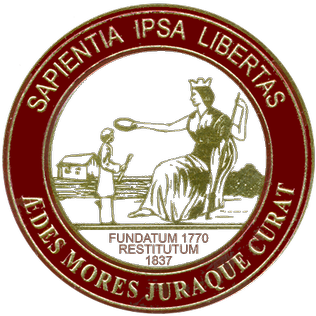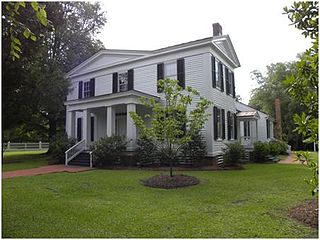
Kenansville is a town in Duplin County, North Carolina, United States. Its population was 770 at the 2020 census. It is the county seat of Duplin County. The town was named for James Kenan, a member of the North Carolina Senate. Liberty Hall, his early 1800s era historic home, is located within Kenansville.

Liberty is a town in Randolph County, North Carolina, United States.

William Alexander Graham was a United States senator from North Carolina from 1840 to 1843, a senator later in the Confederate States Senate from 1864 to 1865, the 30th governor of North Carolina from 1845 to 1849 and U.S. secretary of the Navy from 1850 to 1852, under President Millard Fillmore. He was the Whig Party nominee for vice-president in 1852 on a ticket with General Winfield Scott.

The College of Charleston is a public university in Charleston, South Carolina. Founded in 1770 and chartered in 1785, it is the oldest university in South Carolina, the 13th-oldest institution of higher learning in the United States, and the oldest municipal college in the nation.

A. H. Stephens State Park is a 1,177 acres (476 ha) Georgia state park located in Crawfordville. The park is named for Alexander H. Stephens, the Vice President of the Confederate States of America, and a former Georgia governor. The park contains Stephens' home, Liberty Hall, which has been fully restored to its original 1875 style. The park's museum houses one of Georgia's largest collections of American Civil War artifacts. The park also offers several mill ponds for fishing and nature trails.

The National Register of Historic Places in the United States is a register including buildings, sites, structures, districts, and objects. The Register automatically includes all National Historic Landmarks as well as all historic areas administered by the U.S. National Park Service. Since its introduction in 1966, more than 90,000 separate listings have been added to the register.
The Alice Freeman Palmer Memorial Institute, better known as Palmer Memorial Institute, was a school for upper-class African Americans. It was founded in 1902 by Dr. Charlotte Hawkins Brown at Sedalia, North Carolina near Greensboro. Palmer Memorial Institute was named after Alice Freeman Palmer, former president of Wellesley College and benefactor of Dr. Brown.
This is an incomplete list of historic properties and districts at United States colleges and universities that are listed on the National Register of Historic Places (NRHP). This includes National Historic Landmarks (NHLs) and other National Register of Historic Places listings. It includes listings at current and former educational institutions.

Liberty Hall, also known as the Governor William Livingston House, located on Morris Avenue in Union, Union County, New Jersey, United States, is a historic home where many leading influential people lived. It was documented by the Historic American Buildings Survey (HABS) in 1938. The house was added to the National Register of Historic Places as a National Historic Landmark on November 28, 1972, for its significance in politics and government. It is now the Liberty Hall Museum.

The Playmakers Theatre, originally Smith Hall, is a historic academic building on the campus of the University of North Carolina at Chapel Hill. Built in 1850, it was designated a National Historic Landmark for its architecture, as an important example of Greek Revival architecture by Alexander Jackson Davis. It is now a secondary venue of the performing company, which is principally located at the Paul Green Theatre in the Joan H. Gillings Center for Dramatic Art.
William Augustus Edwards, also known as William A. Edwards was an Atlanta-based American architect renowned for the educational buildings, courthouses and other public and private buildings that he designed in Florida, Georgia and his native South Carolina. More than 25 of his works have been listed on the National Register of Historic Places.

The J. Warren Smith House is a house at 21 North Palmetto Street at the corner of North Palmetto and Edgemont Streets in Liberty, South Carolina in Pickens County. It has also been called "Maggie Manor" and the Myrtle Inn, which were names during its use as a boarding house. It was named to the National Register of Historic Places on January 26, 2005. It is considered an excellent example of a Colonial Revival house and for its connection with J. Warren Smith, who was a local business executive.
Jersey Settlement Meeting House, also known as Jersey Baptist Church, is a historic church and meeting house located near Linwood, Davidson County, North Carolina. The Baptist congregation was founded around 1755 by settlers from New Jersey. Among them was Benjamin Merrill, a local leader in the Regulator movement from 1765 to 1771, who was captured and executed following the Battle of Alamance.
Liberty Hall is a historic house museum in Kenansville, North Carolina. Built in the early 1800s, it was the home of North Carolina state senator and militia general James Kenan for whom the town is named. Kenan commanded local militia during the American Revolutionary War.

Kenansville Historic District is a national historic district located at Kenansville, Duplin County, North Carolina. The district encompasses 18 contributing buildings in Kenansville. It includes predominantly residential buildings with notable examples of Greek Revival, Federal, and Italianate style architecture. Notable buildings include the Brown-Jones House, Kelly-Farrier House, the Kenan House, the Pearsall House, the Graham House, the Isaac Kelly House, the Dr. David Gillespie House, the Grove Presbyterian Church, and the Kenansville Baptist Church.

Liberty Historic District is a national historic district located at Liberty, Randolph County, North Carolina, United States.The district encompasses 48 contributing buildings and 2 contributing structures in the central business district and surrounding residential sections of Liberty. It includes buildings built between about 1880 to about 1950 and notable examples of Queen Anne and Colonial Revival architecture. Notable buildings include the Liberty Depot, Reitzel Building, the Farmer's Union Mercantile Co. Building, the Curtis Theater (1949), Bob Patterson House, the A.J. Patterson House, the Bascom M. and Alpha L. Brower House, J.C. Luther House, the Clarence Kennedy House (1940), and Hardin's Florist.
Willard Close Northup (1882–1942) was an American architect in North Carolina who was the principal partner in the firm Northup & O'Brien. His firm was based in Winston-Salem, North Carolina. Northup began his architectural practice in 1906 and partnered with Leet Alexander O'Brien (1891–1963) in 1915 or 1916. Luther Lashmit joined the firm in 1927, and was lead architect for Graylyn while an employee of the firm.
Lewis Highsmith Farm, also known as Sweet Liberty, is a historic home and farm complex located near Harrells, Sampson County, North Carolina. The house was built about 1840, and is a large two-story, double pile, Federal style frame dwelling with a gable roof. The front facade features a full-width, two-tier front porch. The interior follows a hall-and-parlor plan. Also on the property are the contributing log smokehouse, the former kitchen, the gable roofed barn, and a nearby cluster of four tobacco barns.














